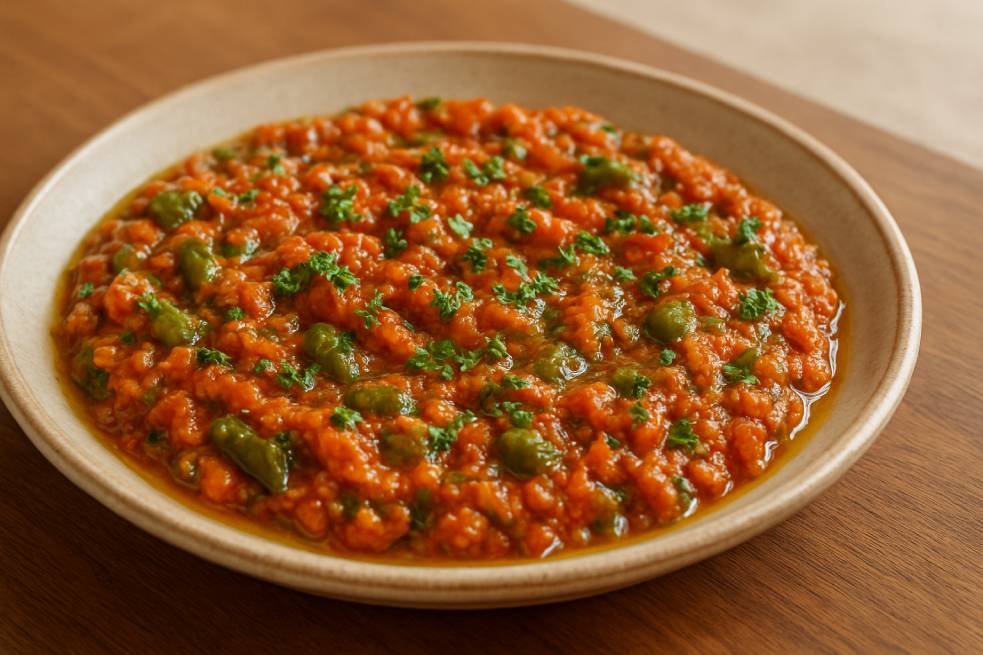Table of Contents
🟢 What Is Taktouka? A Staple of Moroccan Cuisine
Taktouka isn’t just another side dish—it captures the soul of Moroccan home cooking, blending simplicity with deep cultural flavor. 🇲🇦. Often served as a warm Moroccan salad, this flavorful blend of roasted green peppers, ripe tomatoes, and traditional spices like cumin and paprika tells a story of simplicity, warmth, and deep-rooted culinary tradition. Whether it’s placed next to a hearty tagine or part of a family-style mezze platter, Taktouka always adds a burst of vibrant color and bold flavor to the table.
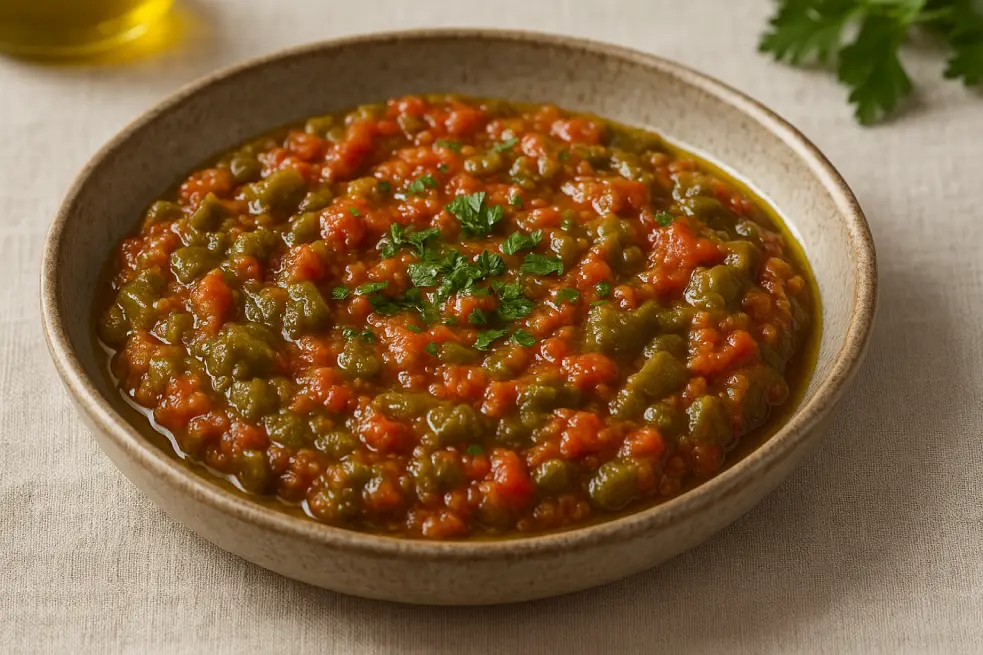
🔶 A Moroccan Salad With Rich Origins
In Moroccan households, Taktouka is as common as mint tea or warm khobz bread. It’s part of the broader tradition of warm Moroccan vegetable dishes, such as Zaalouk, which features eggplant, or Bakoula, a seasoned sauté of wild greens like mallow. These dishes aren’t “salads” in the Western sense of raw vegetables—they’re more like slow-simmered sides, served warm or at room temperature, meant to accompany bread and shared communally. What sets Taktouka apart is its gentle smokiness and the soft, melt-in-the-mouth blend of stewed tomatoes and roasted peppers, offering layers of warmth in every bite.
Traditionally, the green bell peppers are charred or roasted, peeled, and chopped. This process imparts a subtle smokiness that is beautifully balanced by the natural sweetness of the tomatoes. While the ingredient list is short and humble, the resulting flavors carry a depth and warmth that speak directly to the heart of Moroccan home cooking.
🔶 Part of a Vibrant North African Table
You’ll often find Taktouka as part of a Moroccan mezze, served alongside olives, lentils, or zaalouk. It complements both vegetarian and meat-based meals, especially grilled lamb skewers or fish tagines. Its versatility makes it a favorite not only in Moroccan homes but also in modern Moroccan restaurants looking to showcase authentic flavor profiles.
Unlike many modern salads, this one doesn’t rely on raw crunch or creamy dressings. Instead, it brings warmth, earthiness, and a deep connection to North Africa’s culinary heritage. It’s a beautiful embodiment of the Maghreb’s traditional rustic cooking.
🔶 Taktouka vs. Other Moroccan Salads
It’s easy to confuse Taktouka with other Moroccan dishes at first glance. But where Zaalouk leans heavily on eggplant and lemon, Taktouka focuses on just two key vegetables—green peppers and tomatoes—enhanced by garlic and olive oil. That simplicity is what makes it both accessible to beginners and deeply nostalgic to those raised on Moroccan food.
For those interested in learning about the broader context of Moroccan cuisine and how dishes like Taktouka fit into the daily meal structure, exploring traditional Moroccan recipes like Rfissa offers great cultural insight into how layered, seasonal, and generous Moroccan meals can be.
🔶 A Healthy and Flavorful Choice
Taktouka isn’t just flavorful—it’s incredibly healthy. With just a drizzle of extra-virgin olive oil and a generous handful of antioxidant-rich tomatoes and peppers, it’s naturally gluten-free, vegetarian, and a good fit for the Mediterranean diet. No wonder it’s gaining attention among global food lovers searching for clean, wholesome side dishes.
According to TasteAtlas, an international food guide that maps traditional dishes around the world, Taktouka holds its place as a beloved staple of Moroccan cuisine—proof that humble ingredients, when treated with care, can create something extraordinary.
🔷 Ingredients You’ll Need for the Perfect Taktouka
Despite its humble nature, this Moroccan salad relies on the freshness and balance of a few key ingredients to create its bold, comforting flavor. Each component has a role to play — from the roasted peppers that deliver a hint of smokiness, to the ripe tomatoes that give it body and depth. Let’s break down everything you’ll need to make an authentic Taktouka at home.
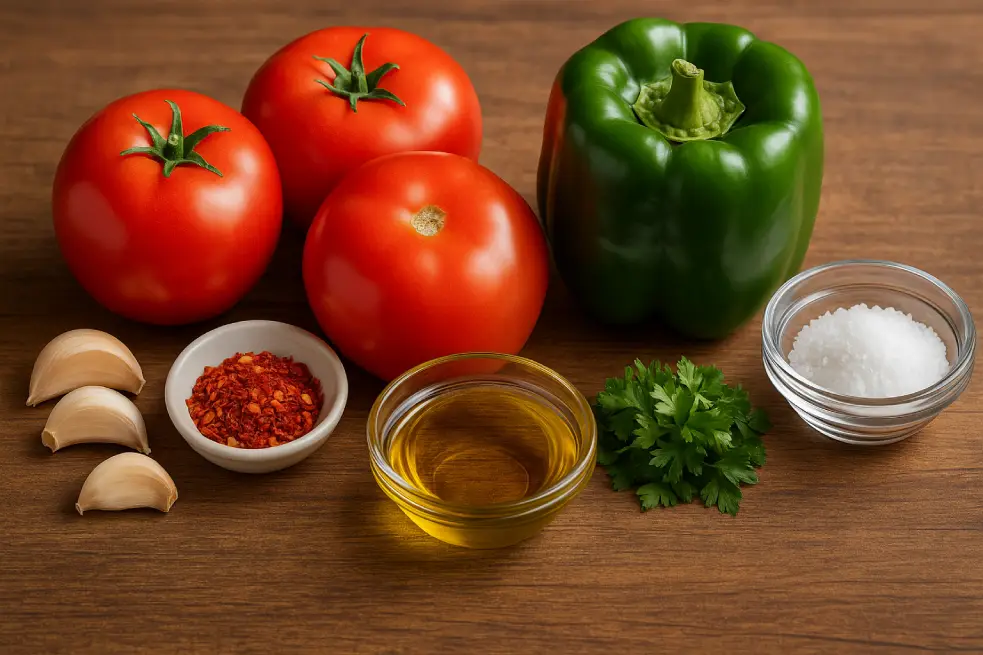
🟧 Core Vegetables: Bell Peppers and Tomatoes
Taktouka is built around just two vegetables: green bell peppers and tomatoes. For best results, use firm, glossy peppers and fully ripe, deep-red tomatoes. Green peppers are usually grilled or flame-blackened, then carefully skinned and diced — this step brings out a mellow smokiness and a tender bite that defines the character of Taktouka. The tomatoes are peeled, seeded, and finely chopped before being simmered down into a rich base — their sweetness perfectly balancing the peppers’ bitterness.
Using in-season vegetables will elevate the entire salad. If tomatoes aren’t at their peak, opt for vine-ripened or Roma varieties, which tend to be more flavorful and less watery.
🟧 Aromatics and Seasonings
Once you’ve got your vegetables, the next step is to infuse them with classic Moroccan spices. You’ll need:
- Garlic – finely chopped or crushed
- Ground cumin – adds earthiness and depth.
- Paprika – for warmth and subtle sweetness
- Salt and black pepper – to taste
These spices are sautéed in extra virgin olive oil, enhancing their aroma before the vegetables are added. The blend of herbs and slow-cooked vegetables creates a rich, layered taste that instantly evokes the warmth of Moroccan kitchens.
. A pinch of smoked paprika can be added for a modern twist to intensify the smoky notes.
🟧 Optional Flavor Enhancers
While not traditional, you can personalize your Taktouka with minor tweaks:
- A splash of lemon juice for brightness
- For a bit of a kick, some like to add crushed red pepper or a spoonful of harissa paste, depending on their spice tolerance.
- A few chopped cilantro or parsley leaves for freshness
These additions won’t detract from the authenticity — instead, they can help you tailor the dish to your palate or the occasion. For instance, a bit of spice makes it a perfect accompaniment to grilled meats.
🟧 Ingredient Quality Matters
Because Taktouka relies on minimal ingredients, quality is everything. Choose cold-pressed olive oil for a richer base, and opt for fresh or canned tomatoes only when necessary. Ideally, your vegetables should be organic or from a trusted local source to ensure flavor and nutrient retention.
This attention to freshness and simplicity is part of what makes Moroccan cuisine so enduring. Like other rustic dishes such as the hearty Harira soup, Taktouka showcases how a few well-chosen ingredients, when combined with care, can create something deeply satisfying.
As noted in BBC Good Food’s Moroccan cooking guide, working with high-quality base ingredients is the foundation of many Mediterranean and North African dishes, and Taktouka is no exception.
🟨 How to Make Taktouka Step by Step
Making this traditional Moroccan salad is a straightforward process, yet it’s the care you bring to each step that genuinely makes the difference. From charring the peppers to gently simmering the tomatoes, the method brings out the full depth of each ingredient, creating a dish that is both comforting and flavorful.
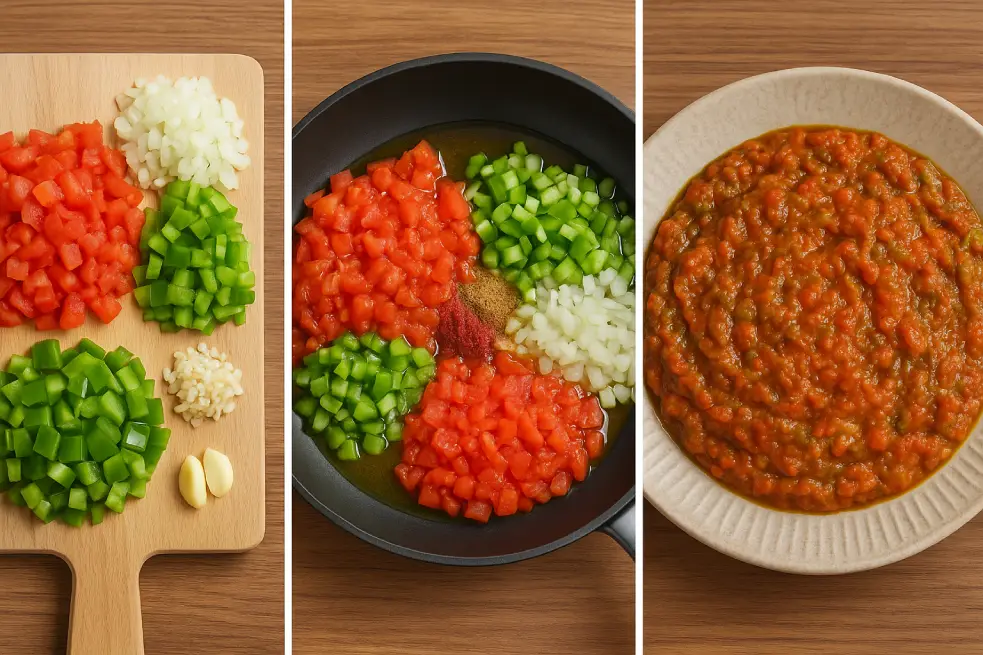
🟩 Step 1: Roast the Peppers to Unlock Their Flavor
Start by grilling or blistering the green bell peppers over an open flame, stovetop burner, or under the broiler until their skins are well blackened on all sides. Once they’ve cooled, peel off the charred skin, remove the seeds, and chop the flesh into small strips or cubes.
This roasting technique is key — it develops a subtle smokiness and softens the peppers just enough to blend harmoniously with the stewed tomatoes. It’s a hallmark of North African cooking, where simple techniques are used to build layers of flavor without being overly complex.
🟩 Step 2: Prepare the Tomato Base
While the peppers cool, blanch the tomatoes briefly in hot water, then peel and chop them finely. Heat a drizzle of extra-virgin olive oil in a skillet or pan, and add minced garlic. Cook gently until fragrant. Stir in the tomatoes and let them simmer over low heat, allowing them to break down and release their natural sweetness.
Aim for a smooth, concentrated tomato mixture that holds together nicely — it should be thick enough to coat a spoon but not heavy or dry. Stir occasionally to prevent sticking, and cook until the mixture has reduced to a rich consistency.
🟩 Step 3: Add the Spices and Peppers
Once the tomato mixture has thickened, it’s time to add the seasonings. Add a touch of ground cumin, a bit of sweet paprika, and salt and black pepper to taste. Let these spices toast briefly in the pan to release their aromas, then fold in the roasted peppers.
Let everything simmer together for another 10–15 minutes, uncovered, until the flavors fully marry and the salad reaches a thick, cohesive texture. Some cooks prefer a chunkier finish, while others stir for a longer time to achieve a more blended result — both are delicious.
🟩 Step 4: Adjust and Finish with a Personal Touch
Before serving, taste and adjust the seasoning as needed. If you enjoy a bit of heat, consider adding crushed red pepper flakes or a small spoonful of harissa paste for extra warmth. For brightness, a squeeze of fresh lemon juice can add balance, especially if the tomatoes are very ripe.
This salad shines when served slightly warm or at room temperature, allowing its full flavor to settle and deepen. Whether spooned onto fresh bread or served alongside a tagine, it’s a soulful dish that tastes even better the next day.
For those who appreciate step-by-step Moroccan cooking, especially when building flavor through layering, you’ll enjoy this method as much as preparing more complex dishes like the Beef and Green Beans Tagine — another satisfying recipe that rewards slow cooking and attention to detail.
The technique of slow-simmering vegetables with spices is also a hallmark of Mediterranean cuisine. As noted by culinary authorities like Serious Eats, it’s this approach — simple ingredients elevated through technique — that gives Moroccan food its lasting appeal.
🟪 How to Serve and Enjoy Taktouka
Once you’ve mastered how to make this Moroccan salad, the next joy lies in presenting it — and luckily, Taktouka is as versatile as it is flavorful. Whether served as a side, a spread, or part of a larger Moroccan feast, its rich, sun-cooked essence adds depth to any table.
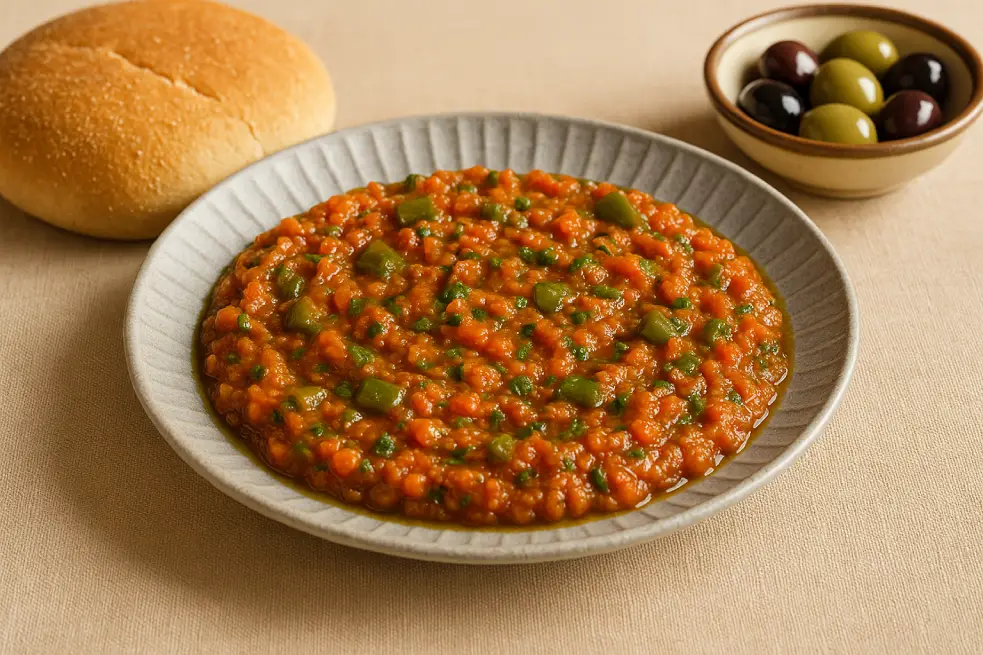
🟥 Serve It As Part of a Moroccan Mezze
In traditional Moroccan meals, Taktouka is often placed among an assortment of cooked vegetable salads — from Zaalouk to lentils and carrots with chermoula. These dishes form the mezze-style starters that open the meal with color, aroma, and balance. Serve Taktouka in a shallow bowl, drizzled with a touch of olive oil and sprinkled with chopped herbs.
This presentation invites sharing, one scoop of khobz (Moroccan bread) at a time. The communal nature of mezze makes it perfect for gatherings, and Taktouka’s bold simplicity makes it a standout on the plate.
🟥 Enjoy It Warm, Cold, or Even Slightly Reheated
One of Taktouka’s advantages is its ability to adapt to different temperatures. After preparation, you can enjoy it while still warm, or let it cool slightly — both methods allow the flavors to develop and settle. In hot weather, some prefer serving it chilled, much like a Mediterranean tapas dish. The texture holds up beautifully, whether fresh or made a day ahead.
This makes Taktouka ideal for meal prep or picnics — a smart option for those seeking plant-based dishes with real depth of flavor, ready to go whenever you are.
🟥 Delicious Pairings for Every Occasion
Taktouka pairs wonderfully with grilled meats, such as lamb chops or chicken skewers, but it can also be served alongside fish or couscous. For a vegetarian meal, try it next to hummus, lentil salad, or grilled eggplant—the soft, savory profile balances well with anything that brings contrast in texture or spice.
Suppose you’re planning a more complete Moroccan spread. In that case, you might consider adding a dish like this Moroccan Vegetable Tagine — the hearty vegetables and warm spices harmonize beautifully with the sweet-smoky profile of Taktouka.
🟥 Storage Tips and Make-Ahead Advice
Letting Taktouka rest overnight allows its flavors to harmonize. Just be sure to keep it well covered and chilled to preserve its freshness. Just let it return to room temperature before serving, or warm it slightly if you prefer a warmer temperature. It will keep well for up to three days, making it a convenient option for busy weeks or gatherings that require advance prep.
According to food preservation guides like The Kitchn, cooked vegetable dishes like this are best stored with minimal air exposure to retain both freshness and flavor integrity.
🟫 Tips, Variations & Final Thoughts
Making a great Moroccan salad like Taktouka is about more than just following a recipe — it’s about understanding the role of balance, texture, and seasoning in traditional Moroccan home cooking. Once you’ve mastered the basic technique, you’ll find that Taktouka invites creativity while still staying rooted in its authentic origins.
🟦 Tips for Maximum Flavor
- Use fire-roasted peppers for a deeper smoky profile. Roasting them directly over a flame brings a richer aroma than oven baking alone.
- Don’t rush the simmering. Allowing the tomatoes to reduce gently gives the salad its characteristic thickness and sweetness.
- Finish with high-quality olive oil. A good drizzle just before serving can lift the entire dish with fruity, peppery notes.
- Serve it with Moroccan bread (khobz) to soak up the juices — it’s the most traditional and satisfying way to enjoy it.
These minor adjustments make a big difference and are part of what turns simple ingredients into something truly memorable.
🟦 Variations Worth Exploring
While Taktouka is traditionally made with just green peppers and tomatoes, Moroccan home cooks often add their touches depending on what’s available:
- Try using red or yellow bell peppers instead of green ones if you prefer a slightly sweeter, milder flavor.
- Stir in a few capers or chopped olives to add a briny contrast.
- Prefer spice? Add fresh chili or a touch of ras el hanout for more complexity.
Each variation adds something new, and none stray far from the spirit of the dish — it’s still all about vegetables, warmth, and flavor harmony.
🟦 Why This Moroccan Salad Belongs in Your Kitchen
Taktouka is easy to prepare, made from whole, real ingredients, and fits beautifully into a vegetarian or Mediterranean diet. Whether you’re planning a casual weeknight dinner or a festive Moroccan feast, it holds its own as a flavorful side or a light main course. What makes it truly special is how its straightforward ingredients come together in such a refined and balanced way.
If you enjoy rustic yet bold Moroccan dishes, you’ll likely love this hearty take on seafood too: Moroccan Seafood Bastilla. Like Taktouka, it combines time-honored methods with unforgettable flavor.
As food writer Claudia Roden has emphasized in her works on Middle Eastern cuisine, the true essence of dishes like this lies in their timeless simplicity and respect for ingredients — something Taktouka captures effortlessly.
🟧 Frequently Asked Questions (FAQ)
🟨 Can Taktouka be made ahead of time?
Yes, and in fact, it’s often better that way. Giving Taktouka time to rest — even overnight — helps the flavors come together more fully. Keep it well covered in the refrigerator, then bring it to room temperature before serving for the best taste experience.
🟨 Is Taktouka served hot or cold?
Traditionally, Taktouka is enjoyed warm or at room temperature. However, it can also be served cold, especially during summer months. Each version brings out different qualities of the dish, so it’s a matter of personal preference.
🟨 Is Taktouka vegetarian or vegan?
Absolutely. Taktouka is naturally vegan and gluten-free, as it contains only vegetables, spices, and olive oil — no animal products or grains. It fits beautifully into a plant-based or Mediterranean-style diet.
🟨 Can I use canned tomatoes?
While fresh, ripe tomatoes are ideal for their flavor and texture, canned tomatoes can be a good substitute, especially if they’re high quality and low in added salt. If using canned, opt for whole peeled tomatoes and break them down as they cook.
🟨 What dishes go well with Taktouka?
Taktouka pairs well with many Moroccan main courses, including tagines, grilled meats, couscous, and vegetable stews. It’s also perfect served simply with fresh bread as part of a mezze or appetizer spread.
🟦 Conclusion: Bringing the Heart of Morocco to Your Table
Taktouka is more than a salad — it’s a glimpse into the heart of Moroccan home cooking. With just a few simple ingredients, it delivers bold flavors, warmth, and authenticity that connect generations around the table. Whether you’re exploring Moroccan cuisine for the first time or adding to your repertoire of Mediterranean dishes, this salad offers a balance of ease and depth that’s hard to resist.
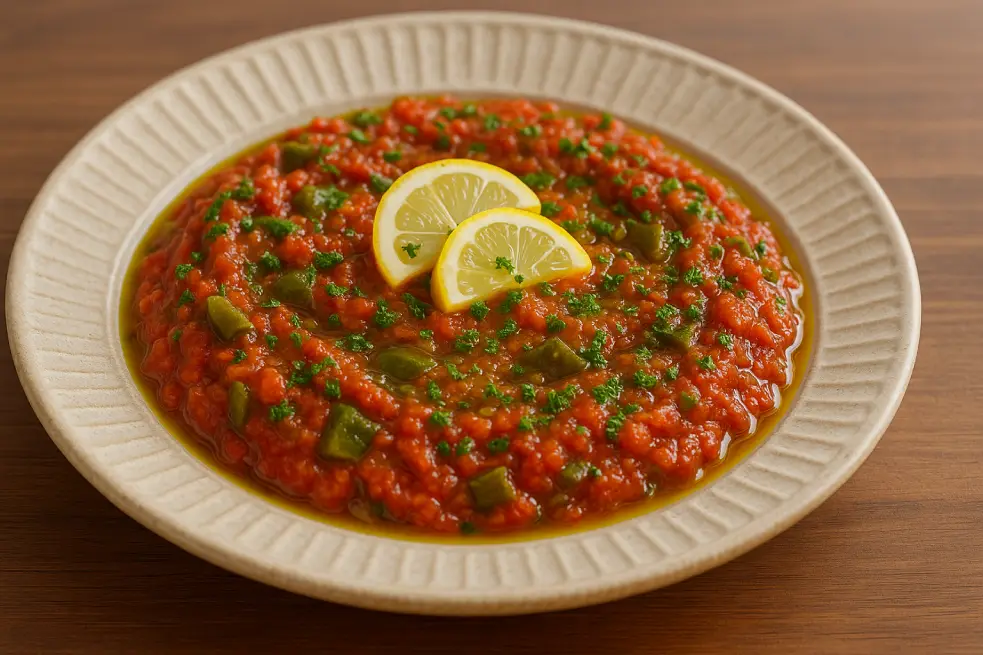
Now that you know how to make this vibrant Moroccan salad, why not bring it to life in your kitchen? Try it out, make it your own, and don’t be afraid to play with the flavors. You’ll be surprised how something so simple can become a new favorite.
👉 Have you tried Taktouka yet? Share your experience, tips, or twist in the comments — and let the conversation (and the cooking) continue!
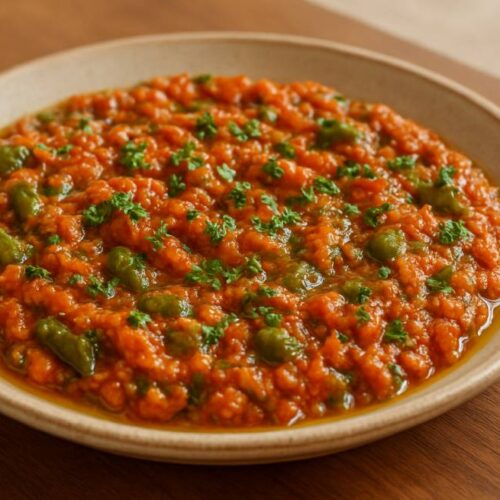
Authentic Moroccan Salad Recipe: How to Make Taktouka at Home
Ingredients
Ingrédients :
- 3 green bell peppers
- 4 ripe tomatoes
- 2 tbsp extra-virgin olive oil
- 2 garlic cloves minced
- 1 tsp ground cumin
- 1 tsp sweet paprika
- Salt and black pepper to taste
- Optional: Crushed red pepper flakes or 1 tsp harissa
- Optional: Juice of ½ lemon
Instructions
Instructions :
- Roast the Peppers:
- Grill or broil the green bell peppers until their skins are blackened on all sides. Let cool, then peel, deseed, and chop into small pieces.
- Prepare the Tomato Base:
- Blanch tomatoes in hot water, peel, and finely chop. Heat olive oil in a pan, sauté garlic until fragrant, then add chopped tomatoes. Simmer over low heat, stirring occasionally, until reduced to a thick, rich sauce (15–20 min).
- Spice and Combine:
- Add cumin, paprika, salt, and pepper to the tomato mixture. Let spices toast briefly. Stir in roasted peppers and simmer uncovered for 10–15 minutes until flavors are well blended.
- Adjust and Serve:
- Taste and adjust seasoning. Add optional red pepper flakes or harissa for heat. For brightness, add lemon juice. Serve warm or at room temperature with bread.
Notes
- The salad can be enjoyed fresh but develops deeper flavor the next day.
- For a smoother texture, cook longer; for chunkier texture, reduce simmer time.
- Inspired by Moroccan cooking traditions and Mediterranean layering techniques.
🥗 Nutrition Information
| Nutrient | Amount (per 1 cup serving) |
|---|---|
| Calories | 130 kcal |
| Total Fat | 9 g |
| Saturated Fat | 1.2 g |
| Carbohydrates | 12 g |
| Sugars | 6 g |
| Fiber | 3.5 g |
| Protein | 2 g |
| Sodium | 280 mg |
| Vitamin C | 90% DV |
| Vitamin A | 35% DV |
💡 Note: Nutritional values are estimates based on a 1-cup serving and moderate use of olive oil. Actual values may vary depending on the specific ingredients used.
📲 Stay Connected with Moroccan Flavors!
Love Moroccan cuisine? Let’s keep the conversation going! Follow us on social media for more delicious recipes, behind-the-scenes cooking tips, and daily inspiration from the heart of Moroccan kitchens. Join our community — we’d love to see your culinary creations and hear your thoughts!
#MoroccanFood #TaktoukaRecipe #NorthAfricanCuisine #HomemadeWithLove #SpiceUpYourKitchen
📨 Join Our Moroccan Kitchen Newsletter!
Get the best of Moroccan recipes delivered straight to your inbox! From traditional tagines to fresh seasonal salads, be the first to discover new dishes, cooking tips, and exclusive content you won’t find anywhere else. Sign up today and bring the magic of Moroccan cuisine into your home — one email at a time.
📩 Join Our Moroccan Foodie Community
Get the best Moroccan tagine recipes and seasonal culinary tips straight to your inbox.
💬 We’d Love to Hear From You!
Tried this recipe or have a question? Leave a comment below and share your experience! Your feedback not only helps us improve but also inspires others in the community to cook with confidence. We read every message and truly appreciate your thoughts.
